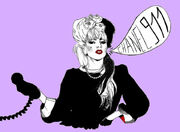V73: The Heroes Issue (Fall 2011)[]
GAGA MEMORANDUM NO. 3[]

Illustrations by Marrow Melow, the winner of the Drawn This Way contest No. 3.
Date: SEPTEMBER 2011
Re: EXTREME CRITIC FUNDAMENTALISM
From: M†SS. GAGA
To: STEPHEN GAN
Copy to:
MS. VREELAND
HAUS OF GAGA
NICOLA FORMICHETTI
V COLLECTIVE
LITTLE MONSTERS
THE WORLD
ART HISTORIANS
INTELLECTUALS
JOURNALISTS
COLUMNISTS
CATHY HORYN
Doesn’t the integrity of the critic become compromised when their writings are consistently plagued with negativity? When the public is no longer surprised or excited by the unpredictability of the writer, but rather has grown to expect the same cynicism from the same cynic? When we can predict the same predictable review from the same predictable reviewer? Accomplished creators of fashion and music have a visceral effect on the world, which is consequently why they are publicly distinguished. So why do so many notable critics seem so impervious to the emotion of the work? Why such indifference? Does intellectualism replace feeling? It’s so easy to say something is bad. It’s so easy to write, “One star, hated it, worst show of the season.” It’s much more challenging to reckon with and analyze a work. It requires research, but maybe no one does their research anymore. So my question, V readers, is this: when does the critique or review become insult and not insight? Injury and not intellect?
I’m going to propose a term to describe this movement in critical journalism: Extreme Critic Fundamentalism. I define this term as instilling fear in the hopes and dreams of young inventors in order to establish an echelon of tastemakers. There is a difference between getting a B- in Biology with a series of poignant red marks from your teacher and being given a spanking with a ruler by an old nun. The former we can learn from, while the latter is just painful. The artist is the general and captain of his or her artistic ship, always ready and willing to take the first blow and drown if an iceberg is hit. But in reviews, should critics not reveal all the scientific, mathematical, and pertinent information to explain why the Titanic could not withstand the blow, or why other cruise ships were successful?
- The temperature of the water.
- The construction of the ship.
- The weight of the cargo.
- The number of passengers.
- The disorganization of the crew.
Where my argument leads is to the perspective space of art, which is subjective and not ultimately rooted in mathematics or physics. Is it not even more critical for fashion and art critics to be profusely informed not only in art history but in the subliminal? The public operates with the assumption that critics are experts in their respective fields. But are they? Does every critic have the soul to really receive a work in the transcendental sense? The out-of-body experience of art?
In the age of the Internet, when collections and performances are so accessible to the public and anyone can post a review on Facebook or Twitter, shouldn’t columnists and reviewers, such as Cathy Horyn, employ a more modern and forward approach to criticism, one that separates them from the average individual at home on their laptop? The public is certainly not stupid, and as Twitter queen, I can testify that the range of artistic and brilliant intellectuals I hear from on a daily basis is staggering and inspiring. In the year 2011, everyone is posting reviews. So how does someone like Ms. Horyn separate herself from the online pack? The reality of today’s media is that there are no echelons, and if they’re not careful, the most astute and educated journalists can be reduced to gossipers, while a 14-year-old who doesn’t even have a high school locker yet can master social media engines and, incidentally, generate a specific, well-thought-out, debatable opinion about fashion and music that is then considered by 200 million people on Twitter. Take Tavi Gevinson. She’s 15, and Rodarte created an entire project inspired by her. Her site is thestylerookie.com. I adore her, and her prodigious and well-written blog is the future of journalism. The paparazzi has similarly been usurped by the camera-toting everyman. That magical moment of the movie star posing in front of the Metropolitan Museum is no longer so magical. Now everyone has a fucking cell phone and can take that same fucking picture.
Why do we harp on the predictability of the infamous fashion critic? The predictability of the most notoriously harsh critics who continue writing their notoriously harsh reviews? Why give the elephant in the room a peanut if it has already snapped its trunk at you? That peanut was dead on arrival. To be fair, Ms. Horyn, the more critical question to ask is: when did the pretense of fashion become more important than its influence on a generation? Why have we decided that one person’s opinion matters more than anyone else’s? Of all the legendary designers I have been blessed to work with, the greatest discovery has been their kindness and their lack of pretense. They care not for hierarchy or position. They are so good, and so precise, that all that matters to them while they’re pinning their perfectly customized garment to my body is the way it makes me feel. Perhaps the pretension belongs in formaldehyde. And the hierarchy is embalmed — for us all to remember nostalgically, and honor that it once was modern, but is now irrelevant. Peanut.



